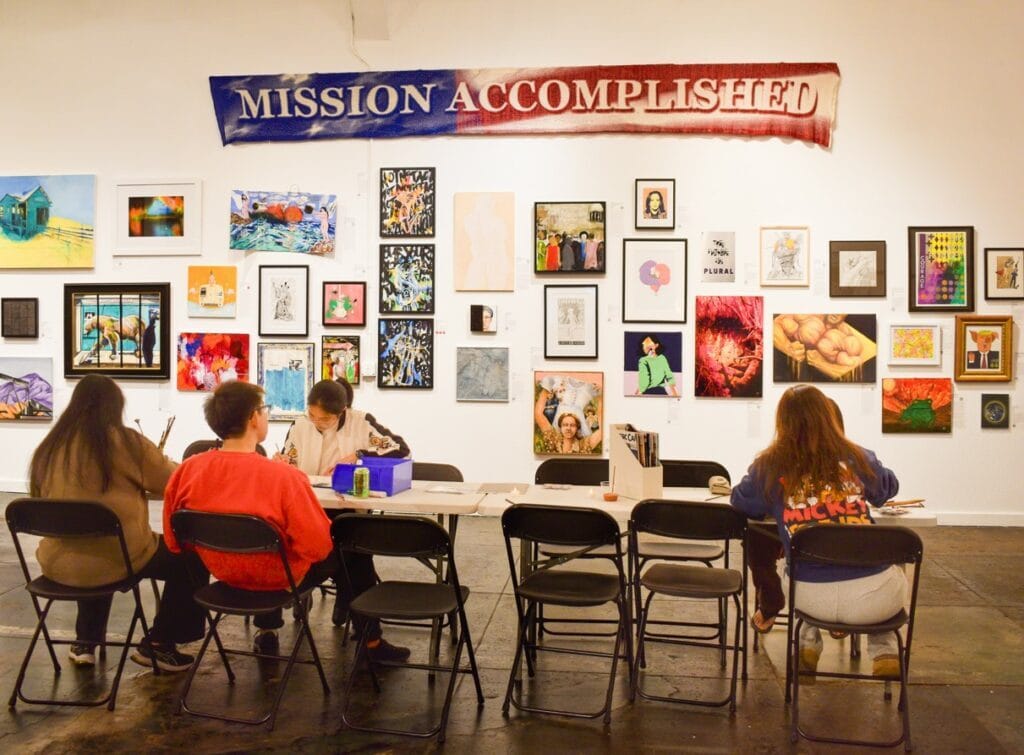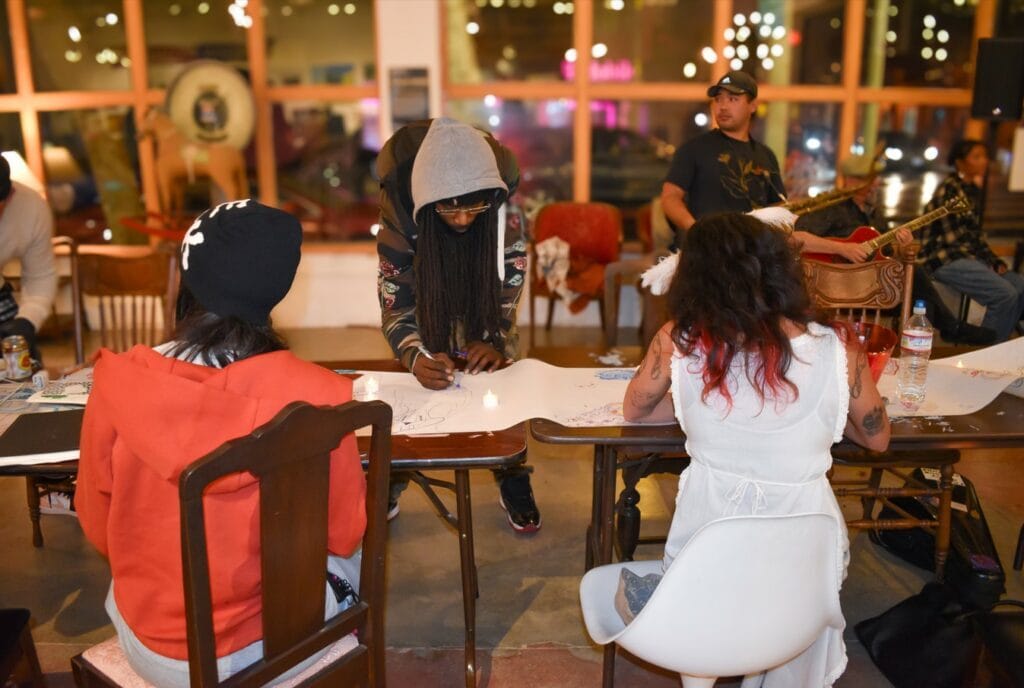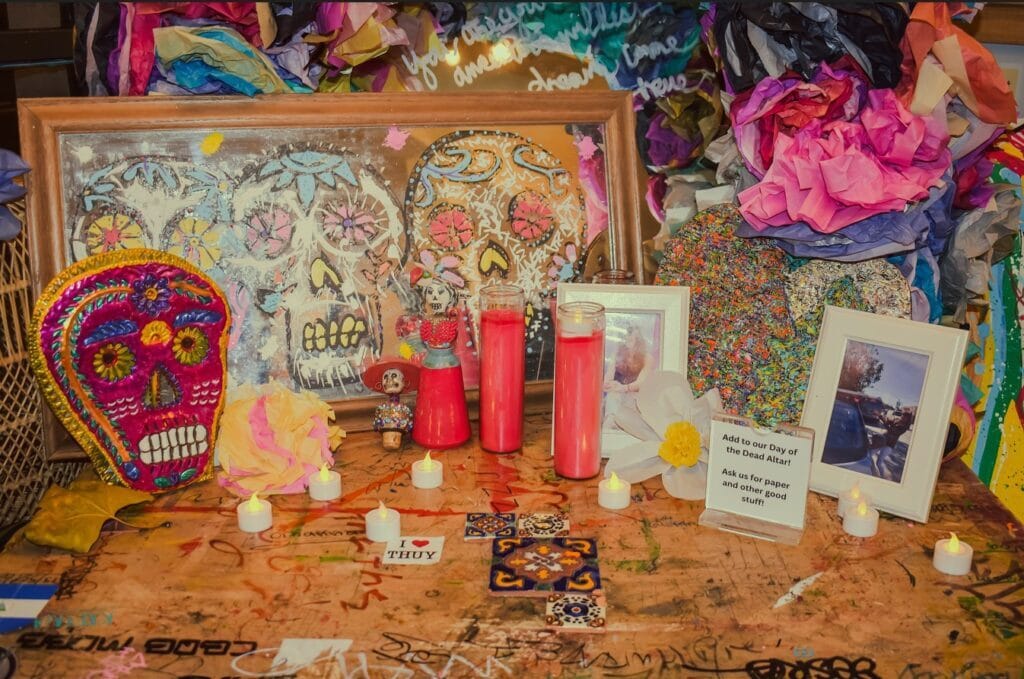By Kellie Hanna

Artist and gallerist Reneé DeCarlo, founder of The Drawing Room in San Francisco. Photo by David Rice.
Meet Renee De Carlo, the Visionary Artist Creating Space for People to Connect Through Art
I’ve known Renee De Carlo as the artist and founder of The Drawing Room, a boutique art gallery on 210 Clement Street in my neighborhood, the Richmond District. The Drawing Room is a true community hub, where neighbors come together to check out art in an unpretentious space. It’s one of Renee’s superpowers: She creates community through art.
When I learned that Renee had revitalized the former Harrington Galleries furniture store at 599 Valencia into The Drawing Room Annex, I was thrilled to join a friend at Communal Table, the gallery’s weekly open art-making event. It’s a vibrant scene: people talking, laughing, and creating at long tables while listening to music from talented local musicians. At one point, I looked up from the collage I was making and told my friend, “I feel like I’m in kindergarten again in the best way!” Since then, I’ve gone back for more.
After chatting with Renee a bit, I wondered what else she’s got up her sleeve. As it turns out, the gallery and Communal Table are pieces of a much larger vision she’s been developing for some time, and I’m excited to share it with you through her words!
Kellie: Can you tell me about the space we’re in now?
Renee: Okay, so we’re sitting in 599 Valencia Street, which is our seventh activation space. Since 2018, we’ve had the opportunity to open up a few significant places. One was up the street at 780 Valencia. We had that for 18 months. It was a humongous, beautiful building all by itself, and we hosted music and other events. That space really put us on the map for this sort of work—bringing distressed retail spaces back to life through art shows, music, and community events.

People Viewing Drawing Room Annex Exhibit, Future Tense. Photo by Kellie Hanna
Kellie: How do you decide which artists to feature in your exhibitions, and what is your selection process like?
Renee: the majority of our exhibitions, especially in our annex spaces are open calls. The idea is to allow artists to come in and work with a theme that’s broad but significant to current events or issues we should be thinking about.—usually related to social, environmental, or political issues.
The principle behind the open call is to create a space where artists can meet, connect, and find one another, and also where the public can engage with the art and ideas on display. Our goal is to bring together not just artists, but also their support systems and a wide range of people from the community in one space, to foster community and collaboration. It’s not just for artists; it’s for everyone, and it always has been.
For example, our current exhibition, “Future Tense,” brings together 70 artists. We launch the announcement of these calls two weeks before we open the call and we only have the call open for 10 days. Through social media, our mailing list–which is at 6000 subscribers–and word-of-mouth, and working with various organizations to promote our calls for art, we get a pretty good number of artists who apply. It’s exciting!
We probably get a 50 to 70% new artist rate, which means that these are new artists who haven’t shown with us before yet they are applying because the call that we’ve had or that we’re launching truly cater to something that pertains to them as artists.
Kellie: Can you share a bit about the challenges you faced with this building, particularly when you first moved in?
Renee: When we came into this space, it had been sitting dormant for about four and a half years, boarded up. Frankly, it was in terrible condition. The exterior was really damaged—windows were tagged, and the big ones were completely broken out. It looked like someone had taken a sledgehammer to them. The inside was also in bad shape.
The building had been unused for so long that it was a real eyesore, which, unfortunately, is common with vacant retail spaces. Retail corridors went through some really dark times, and buildings like this were boarded up to protect them from vandalism. The problem is, once a building gets boarded up, it’s hard to activate it again. But after our time at 780, we saw the need to bring these spaces back to life. We help building owners understand how to activate their dormant buildings and turn them into something positive.
We started talking about moving into this space in October of last year, but we didn’t get the keys until December. Once we had the keys, we worked on cleaning it up and making it usable again. Getting everything cleaned up and ready for the exhibition was a huge undertaking. Our goal is to help building owners understand how to breathe life back into these dormant spaces, and that’s what we’ve been doing here.

Communal Table Participants Creating Art With Gallery Exhibit in Background. Photo Kellie Hanna
Kellie: What kind of experience do you want visitors to have when they walk through the door?
Renee: I want people to feel like they’re a part of the space. I want them to feel like they can connect that they don’t have to be intimidated. In fact, they will come in and either visually or by reading the tags on the wall that relate to the pieces they’ll get the information they need or also have one of our beautiful staff help them navigate any questions you may have. Art is a very personal experience. I’ve also taken it from our daily lives and the interior waves. Galleries don’t exist any longer in our walkways, retailers are closed. And art fundamentally has been taken from the schools, it’s been institutionalized into museums and into galleries where most people cannot afford to be.
I find this to be a situation we need to rectify immediately because art something we all need to have access to easily. We should all know artists. We should all know art spaces. We should all feel like we are part of art movements We do this with our shows, Communal Table, our understudy program. The amount of people who sign our mailing list book– which is in the thousands and follow us on Instagram who share experiences with us when they visit our various spaces as astounding. It’s hard to believe that all of this has started in such a short time. That in itself tells me how deficit our landscape of art is in San Francisco.
Kellie: Your gallery spaces have a real communal feel. How do you foster a sense of connection between artists and the community?
Renee: It’s really about artists coexisting and creating a sense of community. For example, sometimes you might not like a fellow artist’s work, but you have to live with it on the wall. It’s about finding harmony, and sometimes, those connections can lead to friendships or collaborations. It’s like when I host potlucks with other artists in the neighborhood—connecting people who might not otherwise cross paths. I love that aspect of the gallery. It’s not just about individual shows; it’s about bringing people together, especially after COVID when everyone was so isolated. It’s about breaking out of those tiny pods we all created.

People Creating at Communal Table. Photo Kellie Hanna
Kellie: What is Communal Table and why is it important for the gallery and for the community? What is the most rewarding thing about it for you?
Renee: Communal Table evolved out of having access to art supplies that we have an abundance and samples of things nice paper and lots of folding tables. The space we are in right now at 599 Valencia has a beautiful open space that is surrounded by light and windows and interesting lighting fixtures. I set tables out in a long serpentine with paper and buckets of pens on the tables and just let people sit. The space also came with a lot of really interesting antique furniture and chairs so I think there’s a symbiosis between the comfort of a familiar old chair a folding table and a bucket of pens. On a
Friday night this last summer I was working and I never closed the doors and people are in the gallery. I try to really let people stay if they wanna come in; I never turn away anyone. Our door’s always open and before I knew it it was 11 o’clock, and there were no less than 35 or 40 people in the gallery, most of which were walking around the gallery and some were sitting around this Communal Table drawing the people who were walking around, looking at the art. Eventually, they made their way over to the drawing table and sat down and started drawing and of course I couldn’t turn them away. And I realized that I needed to formalize this into an event for people to have access to.
It’s a place where people can come on their way to dinner in lieu of dinner after dinner with their friends, they can trip in stumble, and fall into it and meet someone new. They can listen to music. The price point is accessible. And we provide all the supplies. People can also bring their own, but we don’t have expectations of people. We just want them to connect enjoy themselves the music as an amazing layer to it, finding the balance between music and art and conversation the work on the walls, the show that’s up this event gives even more exposure to the artist who participate in our calls for Art because it attracts people outside of our marketing. It attracts people who are out didn’t know what they were doing walked across the street and next thing you know they stay for two hours, and they doodling with their friends. It’s kind of magic.

Drawing Room Communal Table Altar Dia De Los Muertos. Photo Kellie Hanna
Kellie: Have you noticed any unexpected or interesting outcomes from Communal Table events, such as new collaborations or art pieces that have emerged?
Renee: We also sell quite a bit of art on these nights, at least one to five pieces to
sell, which I think is really cool and again like I said, in the last question, it really helps create a place of both collecting, connecting and open drawing
Kellie: I’ve participated in Communal Table events when there have been no themes and I recently participated in a Dia De Los Muertes themed event. How do you decide when to add themes to the events? Are they based on the neighborhood, exhibitions, holidays….?
Renee: it just depends on what’s going on. Future tense was an election show. Next month is mostly holiday pop-up so our show will be a fun and very consumable show called Modern Menagerie and it will be the centerpiece to weekend pop-ups that are different types of vendors, different types of makers .
Kellie: How has Communal Table grown since you started it in this space?
Renee: at first, I wasn’t sure what was going to happen. We don’t really know how many people will sit and pay, but we average about 40 to 60 people sitting every Friday, the music is evolving also as we rotate DJs both inside and outside, and live music inside. The live music is very casual, and all of the musicians play for tips, only which allows for musicians who were learning their craft to come in and participate with. Drawing makers who are also coming in to explore and learn more and be around other people.
Kellie: The music here is always amazing! Is it from the neighborhood or community?
Renee: Yes, the core jazz musicians are mostly friends of Leanne, who works here. She’s been amazing at connecting with local artists. They’re part of a group that started as a drawing collective called Sketchboard, and they often bring in musicians. It’s very community-driven, and we also have local people coming in to play. The music has become a bigger part of the vibe, but we had to make sure it doesn’t overwhelm the space. Initially, it took over the drawing sessions, so we had to establish boundaries. Music is secondary, and drawing or socializing comes first. We want people to be able to talk.
Kellie: I’ve heard about a Saturday night pop-up event you’re organizing. How will that be different from your usual Communal Table events?
Renee: The Saturday night pop-up is going to be like our Communal Table events, but it’ll be held at [the newest space] the Drawing Room Mission. The first one will align with another holiday pop-up event, and we’re trying to figure out how to co-host and collaborate with other groups. It’s a bit complicated for me because I’ve been running things on my own up until now—no need to check in with anyone—but now, with this new space, I have to plan more carefully and be responsible for it all.
Kellie: What can people expect from the vibe at the Mission Street pop-up compared to Communal Table and other events here at 599 Valencia?
Renee: The vibe at the Mission Street pop-up will be a little different. It’s going to have more of a graffiti culture influence, with a mix of all ages. While it won’t be strictly graffiti kids, it’s definitely going to draw in that crowd. For instance, Method Made Gallery has been trying to create black book nights where people bring their sketchbooks and share their tags. It’s an amazing thing to see—these kids creating art, exchanging tags, and sharing their work with each other. It’s like a community of artists supporting each other in a really authentic way. I didn’t fully understand it until I saw it in action at home, with my own kids and their friends just sitting around, drawing, and sharing ideas in a casual, low-pressure environment.
Kellie: What’s your long-term vision and how do you see your spaces evolving?
Renee: The long-term vision is to continue helping activate these dormant spaces, whether they’re vacant retail shops or other kinds of underutilized properties. We want to show building owners that these spaces can be brought back to life through art, music, and community engagement. It’s about creating a place where people from all walks of life can come together and interact. We also want to keep evolving the kinds of shows we put on and the types of artists we work with—especially artists whose work addresses important social, environmental, and political issues. The space is not just for artists; it’s for everyone, and that’s what we want to continue fostering.
We thought we’d only be here until May, but we got an extension through February. Right now, we’re trying to figure out how to turn the space into an event venue that we can monetize. The idea is to provide affordable event space for nonprofit organizations, so they’re not getting overcharged for hosting events. We want to make this space accessible to these communities and their funders. At the same time, we’re trying to balance that with our own programming, as we survive primarily off donations. We haven’t secured large grants yet, but that’s something we’re working toward. Fortunately, we just got our 501(c)(3) nonprofit status approved, which opens up new possibilities for funding and partnerships.
I hope to start workshops in January. I think after the holidays, it’s the best time to roll them out. We’ll offer things like watercolor-to-oil painting classes and life drawing, maybe even a multi-part series on painting techniques. The workshops will be where we make money, and they’re a way to get people engaged and excited.
Kellie: Wow! Congratulations on your non-profit status! You’re on fire. How does it feel?
Renee: I hope things are taking off, but honestly, right now, we’re not “on fire”—we’re more like smoldering embers. We need someone to add kindling to keep us going, and then bigger support to sustain us long-term. We’re still going because of the programming and the community’s effort. I don’t even know how we’ve made it this far!
It’s definitely about community. People are giving their time, energy, and effort. The community holds things to a high standard, and I’ve learned so much through this process. It’s been incredible.
The Drawing Room Annex, 599 Valencia Street
Communal Table: Fridays from 6-10 pm, $5-$20 sliding scale fee.
Current Exhibition: Future Tense through November 30th
Upcoming Exhibition: Modern Menagerie November 30th, 2024 – January 12, 2025
The Drawing Room SF Instagram: https://www.instagram.com/drawingroomsf/?hl=en
Studio Renee De Carlo Instagram: https://www.instagram.com/studioreneedecarlo/
The post Renee De Carlo’s Drawing Rooms: Uniting Art, Music, and Community in SF appeared first on Broke-Ass Stuart's Website.









